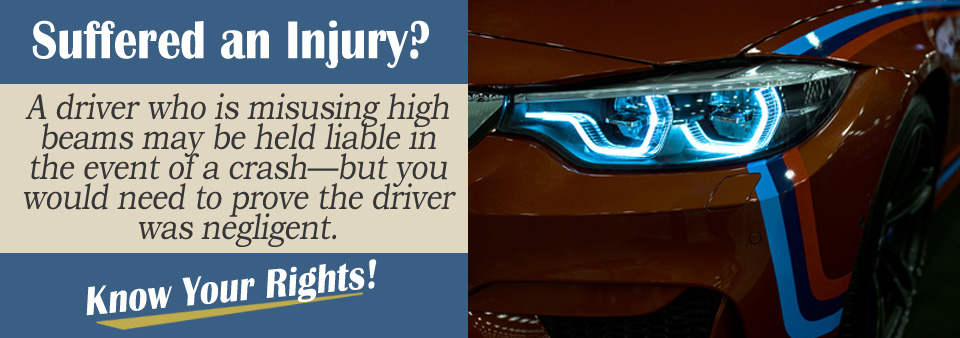Many drivers avoid being on the road at night for the reason that they have a hard time seeing properly on the road. Because it can be so hard to see on the road at night, drivers will often use their high beams to be able to see better.
Using high beams can be a hazard, however, to other drivers on the road. What happens if you get into an accident because the other driver was driving with their high beams on?
We have asked attorney, Alaina Sullivan, about crashes involving drivers using their high beams. Here is what she had to say:
Who Is Liable?
In any car accident, liability depends on the rules of negligence. To show that a driver is negligent, the plaintiff must show that the driver owed a duty of care to other drivers on the road, that the actions taken by the driver violated or breached that duty of care, and that damages or injuries resulted because of that breach.
To show that the other driver who used his or her high beams is liable, the plaintiff needs to prove these elements.
Laws exist that restrict how high beams can be used. Drivers are allowed to use high beams while on the road, but they need to turn them off when approaching another driver on the road. It can depend on the state, but a certain amount of feet between each vehicle is required.
Restrictions exist as to when the driver needs to turn off his or her high beams when approaching a car from behind or from the front. If the other driver who is using his or her high beams fails to turn the lights to normal mode while approaching the other car, thus resulting in a car accident, that driver can be found to be negligent.
This negligence can be increased even more if the driver who had his or her high beams on is tailing the injured driver or operating the car recklessly. However, this is not to say that the injured driver is not at fault.
Holding the Injured Driver Liable
In some situations, the driver who was not using his or her high beams can still be found negligent. All drivers are expected to respond reasonably when facing a hazardous situation.
For instance, if a driver approaches a car with high beams, he or she is expected to respond appropriately. The driver should slow down or even stop to maintain control over his or her vehicle.
If the driver does not react appropriately to diffuse the situation and avoid getting into an accident, the injured driver can be found liable.
Division of Responsibility
Liability is not always a black and white issue. Many times, both drivers hold some level of responsibility for the cause of an accident. This is when the question of comparative negligence comes into play. Many states use the rules of comparative negligence to account for this division of liability.
Comparative negligence will reduce liability of the at-fault driver by the percentage of fault the other driver played into the cause of the accident. Therefore, if the driver using high beams is found to be at-fault but it is also found that the other driver did not react appropriately when approaching the car using high beams, the at-fault driver’s portion of fault could be reduced based on the other driver’s lack of reacting appropriately.
Some states issue a threshold, which means that the at-fault driver must be at least 50 percent to blame for the cause of the accident in order to be held liable.
Other states use a strict contributory negligence standard which means that if the other driver who was not “at-fault,” is even just one percent negligent, that driver is not able to pursue damages against the “at-fault driver.” Only a handful of states use this rule because of how harsh it can be.
Most utilize comparative negligence or modified comparative negligence. You can find some more information about comparative and contributory negligence at these pages:
Contact an Attorney Today
If you have been in a car accident and the other driver had his or her high beams on, it is recommended you contact an attorney to ask any questions you may have. A licensed personal injury attorney will be able to evaluate your case and determine if you have a claim against the other party’s insurance company.
To receive the compensation for your medical bills, property damages, and pain and suffering, you should speak with a personal injury attorney in your area today.

